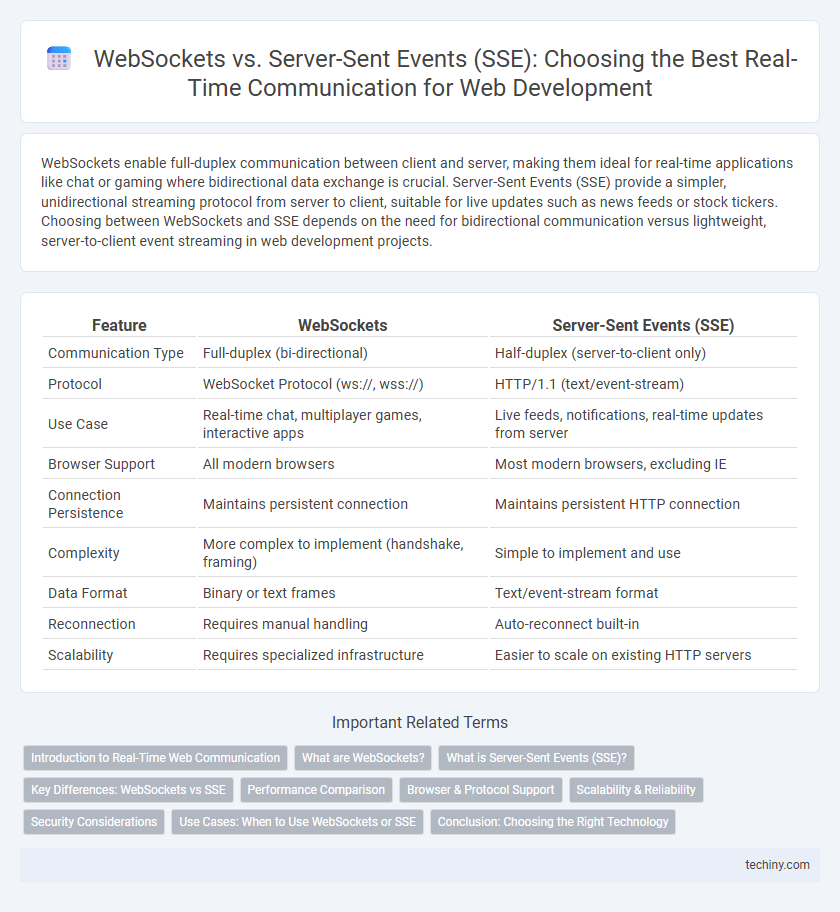WebSockets enable full-duplex communication between client and server, making them ideal for real-time applications like chat or gaming where bidirectional data exchange is crucial. Server-Sent Events (SSE) provide a simpler, unidirectional streaming protocol from server to client, suitable for live updates such as news feeds or stock tickers. Choosing between WebSockets and SSE depends on the need for bidirectional communication versus lightweight, server-to-client event streaming in web development projects.
Table of Comparison
| Feature | WebSockets | Server-Sent Events (SSE) |
|---|---|---|
| Communication Type | Full-duplex (bi-directional) | Half-duplex (server-to-client only) |
| Protocol | WebSocket Protocol (ws://, wss://) | HTTP/1.1 (text/event-stream) |
| Use Case | Real-time chat, multiplayer games, interactive apps | Live feeds, notifications, real-time updates from server |
| Browser Support | All modern browsers | Most modern browsers, excluding IE |
| Connection Persistence | Maintains persistent connection | Maintains persistent HTTP connection |
| Complexity | More complex to implement (handshake, framing) | Simple to implement and use |
| Data Format | Binary or text frames | Text/event-stream format |
| Reconnection | Requires manual handling | Auto-reconnect built-in |
| Scalability | Requires specialized infrastructure | Easier to scale on existing HTTP servers |
Introduction to Real-Time Web Communication
WebSockets provide full-duplex communication channels over a single TCP connection, enabling low-latency, bidirectional real-time data exchange between clients and servers. Server-Sent Events (SSE) offer a simpler, unidirectional stream from server to client, ideal for real-time updates such as notifications or live feeds. Choosing between WebSockets and SSE depends on the use case's complexity, data flow direction, and required scalability for real-time web applications.
What are WebSockets?
WebSockets are a communication protocol providing full-duplex channels over a single TCP connection, enabling real-time interaction between a client and server. They facilitate bidirectional data transfer with low latency, making them ideal for dynamic applications such as chat apps, online gaming, and live data feeds. Unlike traditional HTTP requests, WebSockets maintain an open connection, allowing continuous data exchange without the overhead of repeatedly establishing new connections.
What is Server-Sent Events (SSE)?
Server-Sent Events (SSE) is a technology that enables a web server to push real-time updates to the browser over a single HTTP connection. Unlike WebSockets, SSE is unidirectional, allowing data to flow only from the server to the client, making it suitable for live feeds, notifications, and streaming updates. SSE uses the EventSource API, which simplifies receiving continuous updates without requiring complex protocols or additional handshakes.
Key Differences: WebSockets vs SSE
WebSockets provide full-duplex communication channels over a single TCP connection, enabling real-time, bidirectional data exchange between client and server, while Server-Sent Events (SSE) offer unidirectional, server-to-client streaming of updates over HTTP. WebSockets are ideal for interactive applications requiring low latency and frequent message exchanges, such as online gaming or chat applications. SSE is better suited for simpler, event-driven use cases like live news feeds or stock price updates, where only the server pushes data to the client.
Performance Comparison
WebSockets offer full-duplex communication, enabling low-latency, real-time data transfer ideal for interactive applications such as gaming and live chat. Server-Sent Events (SSE) utilize a unidirectional stream optimized for simpler, event-driven updates like news feeds or stock tickers, generally consuming less bandwidth under lower update frequencies. WebSockets tend to outperform SSE in scenarios requiring rapid, bidirectional messaging, while SSE provides a lightweight, scalable solution for server-to-client event streaming with less overhead.
Browser & Protocol Support
WebSockets offer full-duplex communication supported by all major browsers, enabling real-time, bidirectional data flow over a single TCP connection, making them ideal for complex interactive applications. Server-Sent Events (SSE) provide a simpler, unidirectional streaming protocol supported natively by most modern browsers except Internet Explorer and some older versions of Edge. WebSockets use a distinct protocol (ws:// or wss://) with robust framing and state management, whereas SSE relies on the HTTP protocol with text/event-stream MIME type, impacting compatibility and functionality across different browser environments.
Scalability & Reliability
WebSockets offer full-duplex communication, enabling scalable real-time applications with low latency and high throughput, making them ideal for interactive web apps requiring frequent bidirectional data exchange. Server-Sent Events (SSE) provide a simpler, unidirectional streaming solution that scales well for systems with many clients but less frequent updates, ensuring reliable message delivery through automatic reconnection and event ID-based message replay. Scalability in WebSockets depends on efficient connection management and load balancing, whereas SSE benefits from HTTP/2 multiplexing and simpler infrastructure, enhancing overall reliability in less complex real-time streaming scenarios.
Security Considerations
WebSockets encrypt data through the use of the WebSocket Secure (wss://) protocol, ensuring end-to-end security with TLS encryption, which protects against eavesdropping and man-in-the-middle attacks. Server-Sent Events (SSE) also operate over HTTPS, providing encryption and integrity but are inherently unidirectional, limiting security risks related to bidirectional data exchange vulnerabilities. Both protocols require robust authentication and authorization mechanisms, with WebSockets demanding stricter controls due to persistent connections that increase exposure to potential security threats like cross-site WebSocket hijacking.
Use Cases: When to Use WebSockets or SSE
WebSockets are ideal for real-time applications requiring two-way communication, such as online gaming, chat apps, and live collaboration tools. Server-Sent Events (SSE) are better suited for one-way updates like news feeds, stock price updates, and live notifications where the server continuously pushes data to clients. Choosing WebSockets or SSE depends on the need for bi-directional communication and the complexity of the data exchange in the web application.
Conclusion: Choosing the Right Technology
WebSockets offer full-duplex communication, ideal for real-time applications requiring low latency and bidirectional data flow, such as online gaming or chat systems. SSE (Server-Sent Events) provides a simpler, unidirectional streaming solution optimized for scenarios like live news updates or social media feeds, where only server-to-client communication is necessary. Selecting between WebSockets and SSE depends on application requirements, network complexity, and client support, ensuring optimal performance and resource utilization.
WebSockets vs SSE Infographic

 techiny.com
techiny.com